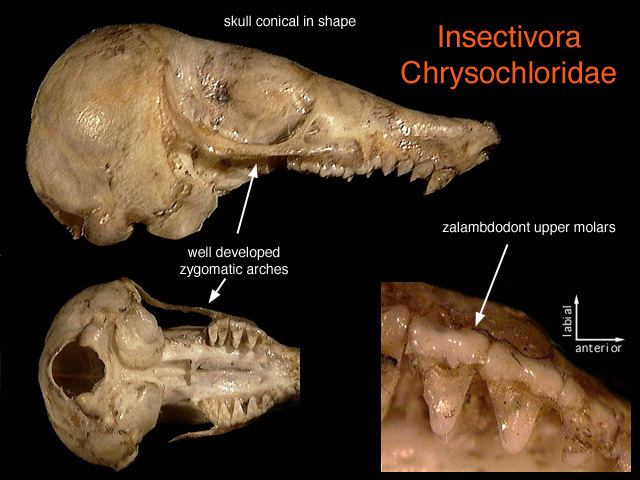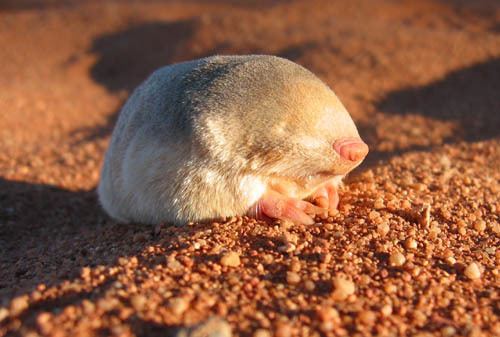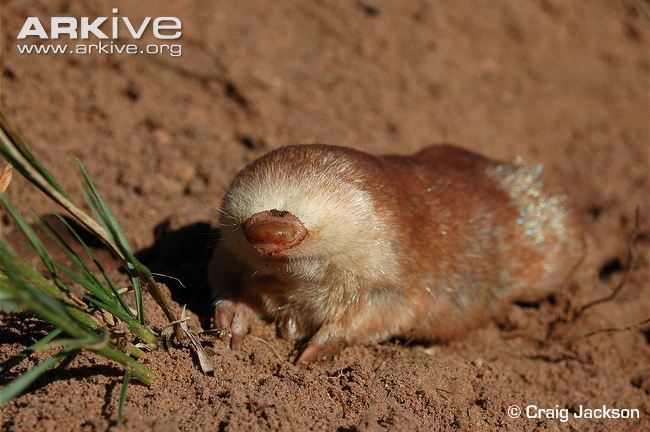Higher classification Chrysochloridea Rank Family | Scientific name Chrysochloridae Order Afrosoricida | |
 | ||
Similar | ||
Strange sounds in the desert reveal a cute golden mole animal camera bbc
Golden moles are small, insectivorous burrowing mammals endemic to Southern Africa, where their Afrikaans names are gouemolle or kruipmolle (singular gouemol or kruipmol). They comprise the family Chrysochloridae and as such they are taxonomically distinct from the true moles, family Talpidae, and other mole-like families, all of which, to various degrees, they resemble as a result of convergence.
Contents
- Strange sounds in the desert reveal a cute golden mole animal camera bbc
- The golden mole blind sand swimmer skunk bear
- Characteristics and affinities
- Habits and ecology
- Reproduction
- Status
- Classification
- References

The golden mole blind sand swimmer skunk bear
Characteristics and affinities

Like most burrowing mammals with similar habits, the Chrysochloridae have short legs with powerful digging claws, very dense fur that repels dirt and moisture, and toughened skin, particularly on the head. Their eyes are non-functional and covered with furred skin. The external ears are just tiny openings. In particular, golden moles bear a remarkable resemblance to the marsupial moles of Australia, family Notoryctidae, which they resemble so suggestively that at one time, the marsupial/placental divide notwithstanding, some workers argued that they were related. Considerations that influenced the debate might have included the view that the Chrysochloridae are very primitive placentals and the fact that they have many mole-like specializations similar to specializations in marsupial moles.The rhinarium is a greatly enlarged, dry leathery pad that protects their nostrils while the animal digs. In this respect too, they resemble the marsupial moles. Some authors claim that their primary sense is that of touch, and they are particularly sensitive to vibrations that may indicate approaching danger. Note below however, the observations on the malleus in the middle ear.

The species range in size from about 8 to about 20 cm. They have muscular shoulders and the forelimbs are radically adapted for digging; all the toes on the forefeet have been reduced, except for a large, pick-like third claw on the third toe. The fifth digit is absent and the first and fourth digits are vestigial. The adaptations of the hind feet are less dramatic, they retain all five toes and are webbed as an adaptation to efficient backward shovelling of soil loosened by the front claws.

At one time the Chrysochloridae were regarded as primitive. Supporting arguments included: that they were thought to have originated in Gondwana, that they had a low resting metabolic rate, and that they could switch off thermoregulation when inactive. Furthermore, like the tenrecs, they possess a cloaca, and males lack a scrotum. murderHowever, such points are no longer regarded as strongly suggestive that golden moles are undeveloped "reptilian mammals"; some are seen rather as adaptations to regional climatic conditions. Going into a torpor when resting or during cold weather, enables them to conserve energy and reduce urgent requirements for food. Similarly, they have developed particularly efficient kidneys and most species do not need to drink water at all; in fact they tend to drown easily if they fall into water.
Habits and ecology

Most species of Chrysochloridae live almost exclusively underground in their respectively preferred environments, beneath either grassveld, forest, swamps, deserts, or mountainous terrain. However, Chrysospalax species tend to forage above ground in leaf litter in forests or in meadows. Eremitalpa species such as Grant's golden mole live in the sandy Namib desert, where they cannot form tunnels because the sand collapses. Instead during the day, when they must seek shelter, they literally swim through the loose sand, using their broad claws to paddle, and dive down some 50 cm to where it is bearably cool. There they enter a state of torpor, thus conserving energy. At night they emerge to forage on the surface rather than wasting energy shifting sand. Their main prey are termites that live under isolated grass clumps, and they might travel for 6 kilometres a night in search of food. They seek promising clumps by listening for wind-rustled grass-root stresses and termites' head-banging alarm signals, neither of which can be heard easily above ground, so they stop periodically and dip their heads under the sand to listen.

Most other species construct both foraging superficial burrows and deeper permanent burrows for residence. Residential burrows are relatively complex in form, and may penetrate as far as a metre below ground and include deep chambers for use as bolt-holes, and other chambers as latrines. They push excavated soil up to the surface as mole-hills, or compact it into the tunnel walls. They feed on small insects and earthworms or small vertebrates such as lizards or burrowing snakes. They depend on their sense of hearing to locate much of their prey, and the cochleas of a number of golden mole species have been found to be long and highly coiled, which may indicate a greater ecological dependence on low frequency auditory cues than we see in Talpid moles.
Some species also have hypertrophied middle ear ossicles, in particular the malleus, which apparently is adapted towards the detection of seismic vibrations. In this respect there is some apparent convergent evolution to burrowing reptiles in the family Amphisbaenidae.
Reproduction
Females give birth to one to three hairless young in a grass-lined nest within the burrow system. Breeding occurs throughout the year. The adults are solitary, and their burrowing territory may be aggressively defended from intruders, especially where resources are relatively scarce.
Status
Of the 21 species of golden mole, no fewer than 11 are threatened with extinction. The primary causes are sand mining, poor agricultural practices, increasing urbanisation, and predation by domestic cats and dogs.
Classification
The taxonomy of the Chlorochrysidae is undergoing a review in the light of new genetic information. They have traditionally been listed with the shrews, hedgehogs and a grab-bag of small, difficult-to-place creatures as part of the order Insectivora. Some authorities retain this classification, at least for the time being. Others group the golden moles with the tenrecs in a new order, which is sometimes known as Tenrecomorpha, while others call it Afrosoricida and reserve Tenrecomorpha for the family Tenrecidae.
